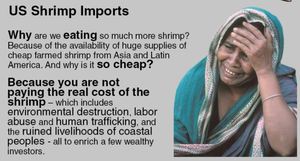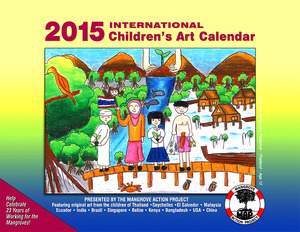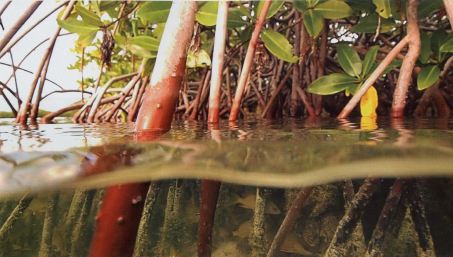Dear Friends of Mangroves The time has come to pass when our actions must speak louder than words! Your continuing support has helped us maintain an active and persistent presence along the coastal belts of mangrove nations. MAP started almost 23 years ago, and has since built up an active global network, while raising public awareness about the importance of mangroves. We have long been the mangroves’ advocate, and have worked tirelessly to conserve and restore these forest wetlands. Future generations may reap the bounty of our actions and thus thank you for your timely support. READ MORE
FEATURED STORY Corals Hide From Climate Change Under Mangroves

USA – A great number of coral populations across the globe have been steadily declining due to the adverse effects of climate change. The NOAA even recently recognized 20 different types of coral as threatened species due to notable decline. However, some coral have found themselves an ally. Mangroves appear to be harboring a great number of coral species, protecting them from things like ocean acidification and elevated temperatures. According to a study recently published in the journal Biogeosciences, more than 30 species of reef corals were discovered growing in Hurricane Hole, a large mangrove habitat within the Virgin Islands Coral Reef National Monument in St. John. The study details how these corals are not only prevalent, but healthy, benefiting from the protection that red mangrove trees are providing the reef-building colonies of invertebrates. READ MORE
AFRICA
Mangrove Charter for West, Central and Southern Africa in the making

SIERRA LEON – Once an abundant resource along the coast and riverine areas in West and Central Africa mangroves are fast being degraded; thereby accelerating ecological damage and impoverishing further the thousands of people who depend on this coastal ecosystem. Arresting this trend has become a matter of urgency for the two subregions. Concerned, the Abidjan Convention “corralled” 20 marine scientists and lawyers in Abidjan 25-27 November to draft a document transforming an existing subregional charter on mangrove management into an additional protocol of the Abidjan Convention. “We are embarking on a historic act on mangroves,” Abou Bamba, the Abidjan Convention regional coordinator, said at the opening of the meeting. “Once complete, the protocol will be the only legally binding instrument on the management of mangroves on the continent.” READ MORE
Wabsa Trains Teachers, Students On Mangroves Regeneration
GAMBIA – The West African Bird Study Association (WABSA) recently organized a daylong training workshop for 40 teachers and students from Lower, Upper and Senior Secondary Schools in Region-two on mangrove regeneration methods and erosion control at Brikama Upper Basic School, West Coast Region (WCR). Similar training was also conducted for 40 teachers and students in Region-one both funded by the Regional Programme on Environmental Education and International Union of Conservation of Nature and Natural Resources (PREE/IUCM). In his PowerPoint presentation before the participants, Lamin Jobarteh, the executive director of WABSA said the aim and objective of the training was to complement The Gambia government's effort to protect the country's remaining flora and fauna. READ MORE
Saudi women fight to save mangrove forests
SAUDI ARABIA – Hardly a month goes by without Najwa Mohammed Bukhari participating in the campaign to "save the mangroves" on the coast of al-Qatif governorate. She did not participate in the latest monthly campaign only because she was not in Saudi Arabia at the time. However, Bukhari’s friends headed to the coast of Saihat City a few weeks ago to save the remains of these trees, which decades ago made up the coastal forest that surrounded the shores of eastern Saudi Arabia. Yet, according to even the most optimistic estimates and official statistics, only 10% of the forest remains; the rest has been destroyed by the ongoing bulldozing and landfill operations which have been taking place over almost four decades to accelerate the growth of urbanization. Saudi Aramco has announced a plan to plant 1.2 million mangrove trees on the coast of the kingdom in four years. READ MORE
ASIA
Protest held against visit of Asia Energy official to Phulbari

BANGLADESH – People against extraction from Phulbari coal mine in open pit method staged a demonstration in the area to protest at the visit of an Asia Energy high official. The chief operation officer of Asia Energy, Gary Lye, went to the area in the morning and exchanged views with the local people to drum up support in favour of extraction of coal in open pit method. Gary was holding an exchange of views at Rajrampur-Fakirpara Workshop when a group of people held demonstrations opposing his visit. They blocked the highway for four hours at Nimtole crossing and held a rally there. Local leader of the national committee to protect oil, gas, mineral resources, power and ports Mortuza Sarker, also the Phulbari mayor, led the protesters as they marched towards Utter Sujapur office of Asia Energy. Those who support Asia Energy attacked the marchers, leaving two people injured and three vehicles parked in front of the office damaged, eye witnesses said. Among the injured, two were admitted to Phulbari Health Complex. No case was filed in this connection. READ MORE
Bali fishermen learn about crabs and mangroves
INDONESIA – With engines roaring, a passenger jet comes in to land at Bali’s airport as a steady stream of traffic crosses the Bali-Mandara toll road across Benoa harbor. This is the fast-paced view of the world from an oasis hidden among mangrove trees, just half a kilometer from Ngurah Rai International airport and less than 100 meters from the toll road. These mangroves and seas abutting one of Bali’s busiest tourist transit zones are home to 96 fishing families who can trace their roots here over generations. It is also home to the Wanasari Fishing cooperative, which was founded in 2009 with the goal of restoring the mangrove environment and raising the living standards of the local fishermen through crab farming. Wanasari is the brain child of Made Sumasa, who says he looked around his home a half-dozen years ago and saw the continuing destruction wrought on the environment by the fishing and wood harvesting methods developed by his ancestors. READ MORE
Residents blow the whistle on mangrove destruction
INDIA – In the years following the Bombay high court’s (HC) landmark 2005 order, declaring mangroves as protected forests, awareness among Mumbaiites about their worth was still rudimentary. In the absence of an active administration, several like-minded citizens took up the responsibility of protecting the mangroves. The New Link Residents’ Forum, Dahisar, is one such citizens group that has fought on ground as well as legal battles to save large mangrove swathes in the suburbs of Dahisar and Gorai. Formed in 2008 to tackle issues of water theft, illegal establishments and street crime, the group consists of residents from 35-40 colonies of New Link Road, IC Colony and Kandarpada.Fighting the destruction of wetlands by the vast slum sprawl of Ganpat Patil Nagar has been one of the mainstays of the group. READ MORE
Mangroves to the rescue
PAKISTAN – The good news from the Indus Delta is that WWF-Pakistan’s efforts have paid off. In December 2012, a delta-wide hazard mapping study was conducted in the area. This study covered the land cover/land use changes (forest changes, land erosion, etc.) through using satellite images and geospatial technology provided by the GIS lab at WWF-Pakistan. The results reveal a significant increase in the forest area of all the three project sites, i.e, Keti Bunder, Kharo Chan and Jiwani, where WWF-Pakistan is working. In Keti Bunder, the increase in the forest cover clearly seems to be the result of plantation activities thereby proving that Pakistan’s coastal areas can adapt to climate change if proper action is taken on the ground. READ MORE
AMERICAS Though this interesting article does not directly mention the importance of mangroves for manatees, there is need to note that mangroves help protect the sea grass beds which are the primary habitat and feeding grounds for manatees and dugongs. By preventing erosion and consequent sedimentation and turbid waters which block sunlight, the mangroves keep the sea grasses healthy and fit for manatee and dugong fodder. As well, the mangroves filter out heavy metal pollutants which can endanger sea life, such as these "sea elephants!" If you want to save these unique creatures, please help MAP conserve and restore our planet's threatened mangroves!
4 Fascinating Facts About Manatees and How You Can Help Them

USA – Manatees are herbivores. They don’t eat other animals and, due in large part to their habitat, no other animals eats them. Unfortunately for them, manatees have to share a planet with us. Despite being on the Endangered Species list and receiving protection under the Marine Mammal Protection Act and the Florida Manatee Sanctuary Act, last year a record 829 Florida manatees died last year. This was due in large part to a toxic algae called red tide. The high number of manatee fatalities last year may not have been directly attributable to humans, but that doesn’t mean we get out of jail free, so to speak. Because manatees live in shallow water and graze on sea grass close to the surface, they are particularly vulnerable to injury by speed boat. Last year in Florida there were 72 confirmed manatee deaths by watercraft, the most of the human-caused fatalities. The African manatee is poached for meat, oil and bones. They are also accidentally killed when caught in fishing nets. In South America, oil spills are a significant threat to the Amazonian manatee, as well as the destruction of habitat. READ MORE
EUROPE
Food supply: Uncharted waters

NORWAY – Under drizzly skies on the west coast of Norway, Thor Halvor Nygaard surveys the fish in the pens floating in the country’s largest fjord. “It’s a good place for the fish,” says Mr Nygaard, the site manager on the Skredstivik farm for the past 15 years, pointing to the fiord’s strong current, which provides oxygen and helps disperse waste. The Sognefjord is best known for its breathtaking scenery, with steep mountains plunging into a flooded valley. But the fjord is also one of the best examples of the rise in fish farming, or aquaculture. Norway’s Marine Harvest, the world’s largest producer of salmon and trout, owns the farm. In a few months, the salmon in Skredstivik’s nine pens will be shipped to supermarkets and grocery freezers in the US and Europe. READ MORE
210 million people benefit from mangroves-associated fisheries
UK – Some 210 million people live in low elevation areas within 10 km of mangroves and many of these directly benefit from mangrove-associated fisheries. Yet, these people are often unaware of the key role mangroves may play, especially if the associated fisheries are offshore. A new study by Wetlands International, The Nature Conservancy and the University of Cambridge concludes that mangrove conservation and restoration in areas close to human populations will render the greatest return on investment with respect to enhancing fisheries. The fisheries value of mangroves is site specific as it depends on how many fish a mangrove produces, how many fish are subsequently caught by humans, and then what the fisheries value is, both in economic terms, as a food supply or through the livelihoods that they support. This reports highlights the key role of mangrove-associated fisheries as an effective strategy for ensuring food security, which enables communities to become more resilient to disasters. It asserts that the loss of mangroves does not only lead to loss of a coastal defense system, but also to loss of livelihoods and food security. The report discusses some of the ecological processes which underpin the key role of mangroves in fisheries enhancement, and gives an exploration of the different mangrove-associated fishery types. READ MORE LAST WORD(S) Colleagues and friends in mangroves and/or Mapping Ocean Wealth
Please check out the latest two products which summarize some of our ongoing work around valuing mangroves. We hope these will be useful to others, in NGOs, governance, industry and the international policy arena. We think they could/should empower greater consideration of the value of mangroves into ongoing coastal planning and conservation efforts. Please forward or share if you like them!
1 – Mangroves for coastal defense: Guidelines for coastal managers & policy makers As the title suggests this is a document that summarizes the detailed reports that Anna McIvor led on the various roles of mangroves in reducing the impacts of various coastal hazards (those reports can also be downloaded here: wind swell and waves (click to download) , storm surge (click to download), soil surface elevations (click to download) ). (Hard copies are available)
2 – The Role of Mangroves in Fisheries Enhancement. This is a detailed synthesis of a review that we have conducted here. It is part of ongoing work to develop a more detailed model and map of mangrove fisheries value that we hope to share in due course. (The link here is to the Wetlands International site, but it will be loaded onto the TNC site – nature.org/oceanwealth very soon)
Both of these have been produced through a highly productive collaboration with Wetlands International, and with support from the Waterloo Foundation and TNC’s Mapping Ocean Wealth project funded by the Lyda Hill Foundation.
All best fishes!
Dr Mark Spalding
Senior Marine Scientist, Global Marine Team, The Nature Conservancy
c/- Department of Zoology, University of Cambridge
Downing Street, Cambridge, CB2 3EJ, UK
T. +44 1223 334459
M. +44 7761 493256
Skype: mdspalding
E. mspalding@tnc.org BACK TO TOP
Not yet a subscriber? Click here to subscribe. Please cut and paste these news alerts/ action alerts on to your own lists and contacts. Help us spread the word and further generate letters of concern, as this can make a big difference in helping to halt a wrongdoing or encourage correct action. | Action Alerts: 
MAP’s annual fundraising drive on now! READ MORE
The importance of mangroves to people: A call to action CLCIK HERE UK National Contact Point final statement on a complaint against a UK company developing plans for coal mining in Bangladesh CLICK HERE
MARVELLOUS MANGROVES IN BRAZIL
En Portuges
MAP VOLUNTEER Statement of Qualifications CLICK HERE WORLD WETLANDS DAY IS FEB 2, 2015 –
MORE HERE
Mamelo Honko Women's Association Update – your support has helped – VIEW REPORT Shrimp is the most consumed seafood in America, but how much do we really know about the shrimp we’re eating? Click here to call on the President’s task force to support seafood traceability and other strong measures to fight IUU fishing and seafood fraud – the task force is running out of time so act now! Development Coordinator Wanted
MAP is seeking a creative, energetic, and environmentally aware development coordinator to support administrative work and the QYS campaign in Seattle, Washington. READ MORE FREE MAP Mangrove e-cards CLICK HERE
 MAP’s e-Cards offer you a unique way to spread the word about MAP’s good works, while sharing beautiful photographs of the mangroves Information sheds clear light on shrimp-mangrove connection

SEE DETAILS MANGROVE/SHRIMPCALLING FOR MANGROVE ART SUBMISSIONS!
A fun and exciting Art Contest for children 6 to 16 years old. We invite all primary school children from tropical and sub-tropical nations, and whose schools are located near mangroves, to create art telling us “why mangroves are important to my community and me?”. Selected winners will be published in a 2016 calendar to be distributed internationally to raise awareness of mangrove forest ecology. READ MORE SHARE MAP'S VISION
CLICK HERE to watch short introductory video. Together we can work "at the roots of the sea". Join us in saving our beautiful country!
We hope you have been following the ongoing battle in Bimini, Bahamas.
We are in need of your help more than ever Click here
Exclusive Interview with Alfredo Quarto, Co-Founder and Executive Director of Mangrove Action Project – See more
MAP VOLUNTEERS NEEDED IN THAILAND VIEW REQUIREMENTS
Order your 2015 Calendar

1-20 calendars, $12 each plus shipping
21-49 calendars, $10 ea plus shipping
50-100 calendars, $8 each plus shipping.
Over 100 $7 each plus shipping
Donate to MAP via Paypal
Giving could never be easier  It’s the action, not the fruit of the action, that's important. You have to do the right thing. It may not be in your power, may not be in your time, that there'll be any fruit. But that doesn't mean you stop doing the right thing. You may never know what results come from your action. But if you do nothing, there will be no result. —Mahatma Gandhi It’s the action, not the fruit of the action, that's important. You have to do the right thing. It may not be in your power, may not be in your time, that there'll be any fruit. But that doesn't mean you stop doing the right thing. You may never know what results come from your action. But if you do nothing, there will be no result. —Mahatma Gandhi Green Planet Fundraising Assists MAP – LEARN MORE
MANGROVE ISSUES View New Videos posted by MAP Asia intern, Delphine. CLICK HEREThe importance of restoring mangroves in an effective, long-term manner. Mangrove video – VIEWPlease view our new video for our Question Your Shrimp Consumer/Markets Campaign! It is now on our website under the Question Your Shrimp section heading. WATCH VIDEO Mangrove Restoration in Asia – Watch Short Video

READ A MOSAIC OF LIFE” Peek into the underwater world of mangroves, "womb of the sea." By Liz Cunningham Photos By Wes Matweyew and Liz Cunningham View MAP’s uploaded Videos at MAPmangrover’sChannel
Marvellous Mangroves 
Marvellous Mangroves – A Curriculum-Based Teachers Guide.
FOR MORE ON MAPs AWARD WINNING CHINA MANGROVE CURRICULUM VISIT

VIMEO SHOW VISIT OUR "MM" WEBPAGE Check out our presentation for more details on Marvellous Mangroves “Education In The Mangroves" can now be seen on the PhotoPhilanthropy website here! Read this 10 page history of the development of MAP’s educational curriculum VIEW DOCUMENT
Article in Canada's Green Teacher Magazine – Read More
"Question Your Shrimp" Campaign Learn more about the affects of the shrimp industry on mangroves by visiting our blog Editor’s Note: Mangrove Action Project’s Executive Director, Alfredo Quarto was interviewed about shrimp by Green Acre Radio’s Martha Baskin LISTEN TO INTERVIEW
Join MAP on Facebook
Sign the Consumer's Pledge to avoid imported shrimp

Not yet a MAP News subscriber?
Click here to subscribe.
Note to Our Readers:
We strive to keep active links in our newsletter. However, due to circumstances beyond our control, occasionally links to stories may become broken. If you find a link to a story is not functioning, please cut and paste the headline into your browser search bar. In most cases you should be able to locate the original story.
Help Mangrove Action Project through your recycled E-Waste. List of Accepted E-waste Items: Injet Cartidges, Cell Phones, Pagers, GPS, Radar Detectors, Mobile Hot Spots, Calculators, eBook Readers, iPods/MP3 players, Digital/Video Cameras/Camcorders, PDAs, iPads/Tablets/Laptops, Video Game Consoles, Handheld Video Games Visit the Mangrove Action Project recycle website Click on the recycle button then click on the Download Shipping Label, and follow the instructions. 
|














